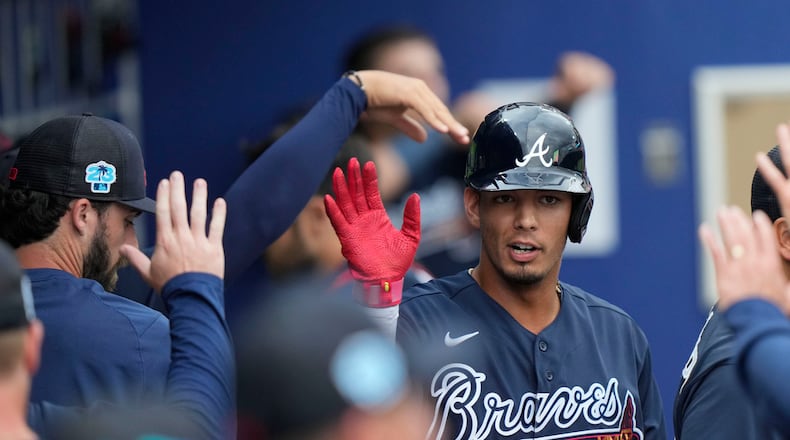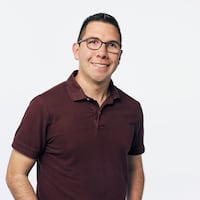NORTH PORT, Fla. — Vaughn Grissom or Braden Shewmake?
Neither.
The Braves optioned both to Triple-A Gwinnett. And as of now, barring a trade, Orlando Arcia will be the Braves’ starting shortstop. Ehire Adrianza will serve as a backup infielder.
On Monday evening, the Braves also optioned right-hander Nick Anderson, and outfielders Jordan Luplow and Eli White, to Triple-A. They reassigned left-hander Danny Young, infielder Yolmer Sánchez, and catchers Ryan Casteel and Joe Hudson, to minor-league camp. Atlanta now has 32 players in big-league spring training and must trim it to 26 ahead of opening day.
The Braves held meetings with these players to explain their decisions ahead of the Tuesday off day.
Let’s break down the moves and why the Braves made them.
Orlando Arcia over the prospects: Why?
To the Braves, Arcia has looked good in spring training after putting together a good season in 2022.
Last season, Arcia had a 104 OPS+, which is better than the league average. (OPS+ uses a player’s on-base plus slugging percentage and standardizes the number across the sport, accounting for external factors including ballparks. The league average is 100.) The Braves view him as someone with a cannon for an arm and terrific hands. Defensively, he can play shortstop every day.
Depth also became a large factor for the Braves. Carrying Grissom and Arcia would’ve meant losing Adrianza and, thus, cutting into organizational depth.
Let’s go through it.
If the Braves had put Grissom or Shewmake on the opening-day roster, they would’ve had to make either of them the everyday shortstop. Why would they take a prospect on the roster if he’s going to sit part of the time? It might stunt development.
And if a prospect became the everyday shortstop, Arcia would be the backup infielder, leaving Adrianza as the odd man out.
And if Adrianza were the odd man out, he could’ve opted out of his deal as an Article XX(B) free agent. To qualify for this rule, a player must have at least six years of service time – Adrianza has eight and change – and have finished the last season on the team’s 40-man roster or 60-day injured list. If the Braves didn’t place Adrianza on their opening-day roster, they would’ve been forced to grant him his release.
Putting it simply: The Braves wanted to keep their depth, so Arcia will be the starter while the prospects go down to Triple-A to begin the season.
Heading into the spring, the Braves made this clear: They would have an open shortstop competition between Grissom and Arcia. Shewmake eventually turned heads.
This spring, Arcia is batting .240 with a .727 OPS over 25 at-bats. Grissom is hitting .323 with a .748 OPS over 31 at-bats.
In 2022, Arcia hit .244 with a .733 OPS and nine homers over 209 at-bats. Grissom hit .291 with a .792 OPS – and a 121 OPS+ – over 141 at-bats.
Since the end of 2020, Arcia has only made six starts at shortstop. He played second base 50 times last season. The Braves also love Arcia’s durability. He played 152 of 162 games in 2019 and 59 of 60 in 2020. He also made a swing adjustment that he’s used the last couple seasons.
The Braves viewed it like this: Grissom would’ve had to have been much better than Arcia to win the job, especially because the Braves would lose depth in Adrianza. They value this because last season, they used a multitude of players – Phil Gosselin and Robinson Canó among them – and didn’t want to lose depth before a pitch had been thrown in the regular season.
It seems like, at this moment, the Braves aren’t completely sure Grissom and Shewmake are better shortstops than Arcia. Could they be superior in the future? Sure. But perhaps not right now.
Thus, the Braves felt Grissom would need to clearly exceed Arcia to sacrifice their depth. To them, he did not.
What’s next for Vaughn Grissom and Braden Shewmake?
At Triple-A, Grissom and Shewmake will play shortstop and second base. Grissom will see more time at shortstop because he’s had fewer innings there in professional baseball than Shewmake.
To the Braves, this cannot hurt either of them. They’ll play every day. Grissom gets more innings at short. Shewmake gets to prove his offensive adjustments are real.
The Braves see Grissom as someone who was good enough to make the roster had the alternative not been as attractive as Arcia. For example, Austin Riley became the everyday third baseman a few years ago because the alternative was Johan Camargo.
The Braves view Grissom as someone who could be better than Arcia in the long run – Grissom is only 22 years old and features exciting upside. But right now, with Arcia playing well – especially over the last week, in the team’s eyes – he’s the better option. Arcia, who turns 29 in August, is entering the second year of a two-year, $3 million contract that includes a club option for 2024.
Grissom or Shewmake could force their way into the mix. If Arcia doesn’t play well, the situation changes. But the Braves think that, at this moment, Arcia might be a bit better option to begin the season.
Despite Shewmake’s impressive spring, the only way he would’ve made the team was in a platoon role with Arcia. This is why the Braves started Shewmake against righties Tanner Houck and Kenta Maeda in recent days – they wanted to get more answers on his bat.
Grissom and Shewmake are relatively opposite. Grissom is young and had a fast developmental track before the Braves called him up. At 25, Shewmake has had more time in pro ball.
Last season, manager Brian Snitker primarily played Arcia over Grissom down the stretch, including in three of the four games versus the Phillies in the National League Division Series. Grissom struggled down the stretch.
As the Braves pondered the decision to option both, they thought about how opening day is an arbitrary date. Things can change throughout the season. If the Braves are wrong – and they know they could be – they can simply reverse course and call up Grissom or Shewmake.
Why Ehire Adrianza fits with the Braves
For the Braves, Adrianza is the perfect utility infielder.
He’s an egoless veteran. He knows his role. He’s fine with it.
In this role, Adrianza might not play for a week at a time. The Braves see him as someone who wouldn’t sour because of this, or even worse, affect the clubhouse chemistry.
The Braves could’ve carried anyone as a 26th man, but Adrianza profiles well for the role. The team doesn’t think he’ll cause problems while serving a limited role.
Last season, Adrianza had a .470 OPS over 97 at-bats. In 27 at-bats this spring, Adrianza is batting .296 with a .925 OPS.
Why did the Braves option Nick Anderson?
Before getting optioned, Anderson had allowed three runs over eight innings. He had 11 strikeouts with one walk. He touched 95 mph on several occasions.
Anderson looks to be returning to his pre-injury form. It seemed as if he might be pitching so well that the Braves couldn’t leave him off.
It came down to depth. Anderson has minor-league options remaining. Due to this, it seems like the move had more to do with the options than Anderson’s performance.
This is probably disappointing for Anderson, who also garnered interest from the Mets and Royals over the offseason. Had he signed with either one of them and pitched this way – which is no guarantee – he probably would’ve made the opening-day roster for those respective clubs.
The other relievers left in camp who could make the opening-day bullpen: Jesse Chavez and Michael Tonkin. Tonkin doesn’t have any options remaining. Chavez can provide the team with length because he pitches multiple innings. He’s also an Article XX(B) player.
To carry Anderson on the opening-day roster, the Braves probably would’ve had to view him as a late-inning reliever – otherwise, why would they risk their depth?
Why did the Braves option Jordan Luplow and Eli White?
Luplow came into spring training with a right oblique strain. It put him behind the other outfield competitors: Kevin Pillar, Sam Hilliard and White.
Plus, Luplow and White have options. Hilliard is out of options. Pillar is an Article XX(B) player. The Braves likely would’ve lost him had they not put him on the opening-day roster.
Nothing is official, but it seems like Pillar and Hilliard will make the team as the Braves try to keep their depth.
Luplow simply needs at-bats. If he gets hot down in Triple-A, he should be called up when a need arises. But he had minor-league options remaining, as did White.
One theme of Monday’s moves: The Braves value depth. It heavily factored into their decisions.
About the Author
Keep Reading
The Latest
Featured



